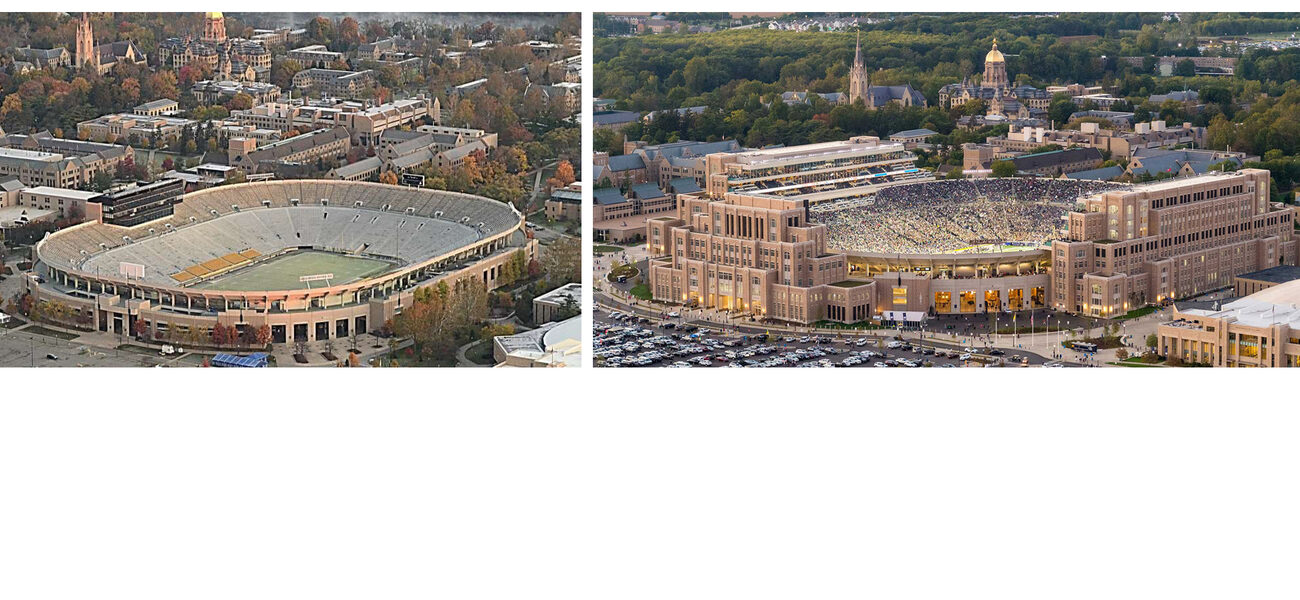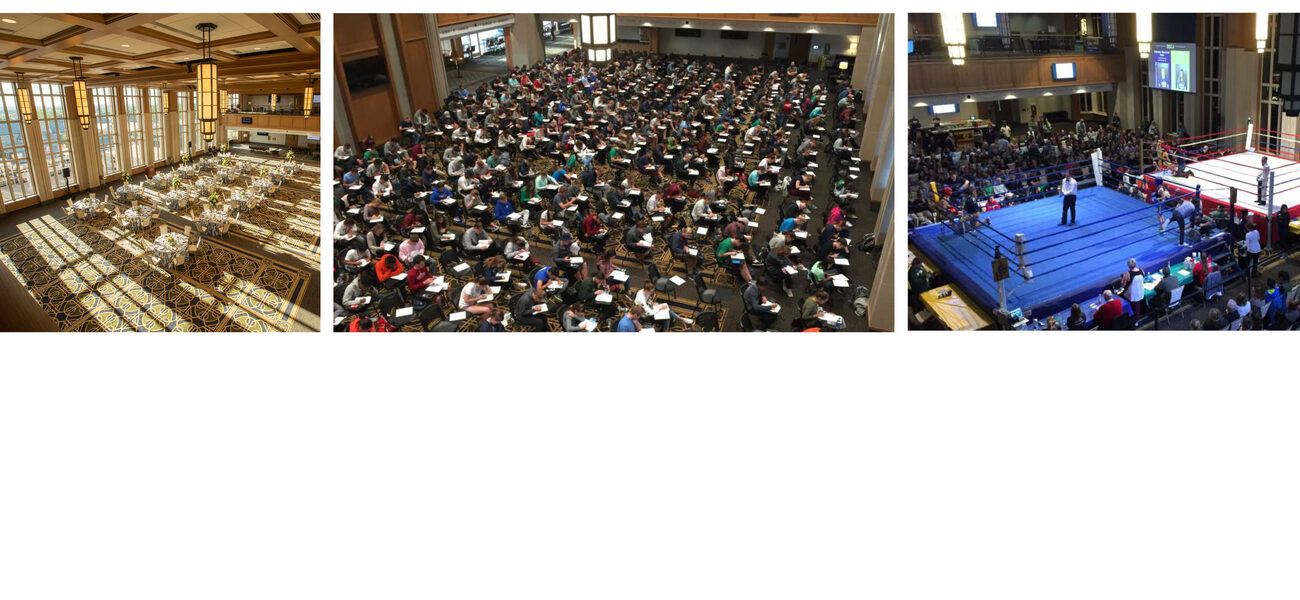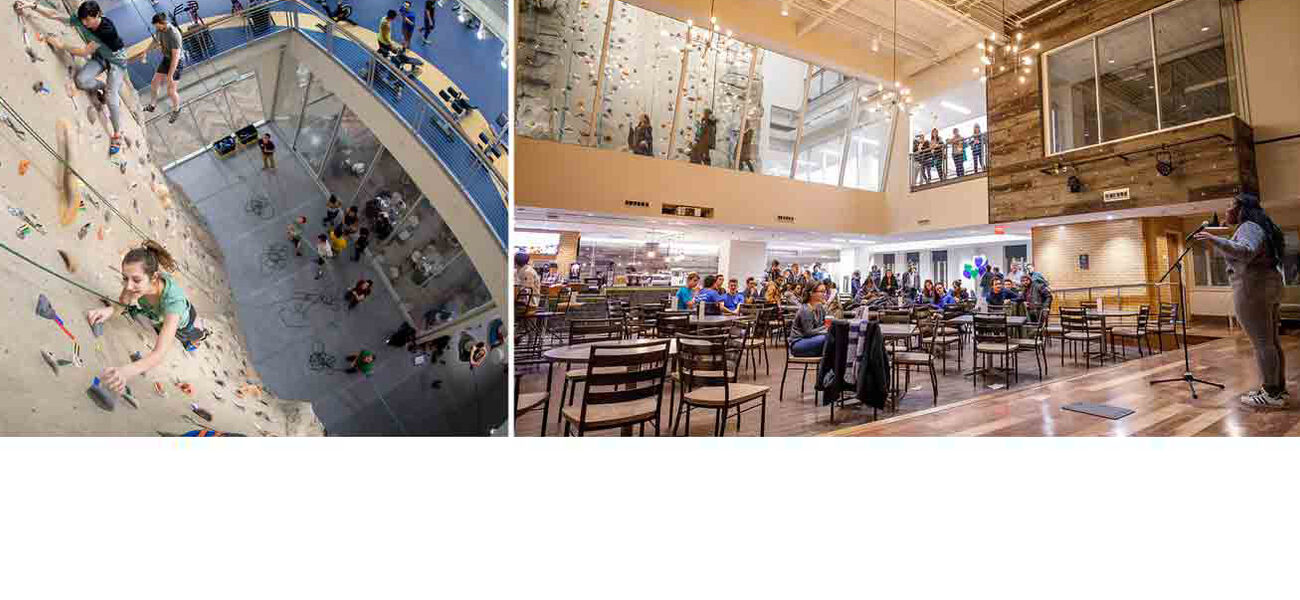The University of Notre Dame’s Campus Crossroads project, compleletd in 2017, transforms the iconic Notre Dame football stadium into a vibrant multi-use campus hub and student center with near constant activity. As the largest, most ambitious construction project in the university’s 175-year history, the stadium remodel includes the addition of three new adjacent buildings that provide more than 800,000-sf of academic, athletic, and student life space designed to increase interaction and wellbeing.
The three new buildings—Duncan Student Center, Corbett Family Hall and O’Neill Hall, are attached to the west, east, and south sides of the stadium respectively. The integrated, hybrid complex combines the previously dispersed departments of psychology, anthropology, and music with state-of-the-art digital media studios, as well as expanded student life, fitness, and recreation facilities.
“One of the great things about this sort of mixed-use project is that raising money for initiatives like a new anthropology or psychology building is not the easiest thing,” says Mary Jo Olenick, director of strategic development at the SLAM Collaborative. “But when you tie them into other things, it can really appeal to a broad base of alumni and help move things along.”
The Campus Crossroads project rose out of the university’s desire to create an integrated student/faculty community space in a centralized location that could also provide more academic and fitness facilities. Since the campus has slowly grown around the football stadium over time, it served as the ideal anchor for a centralized complex. Also, prior to the opening of Campus Crossroads, the stadium was used only eight days a year for home games and commencement ceremonies, so it was a prime target for better space utilization and creative programming strategies.
“We were charged with looking at how to transform this facility to make it active year round,” says Steven Ansel, principal at the SLAM Collaborative. “It involved the audacious goal of bringing academics, athletics, and student life together into a single location that could serve as a hub of learning and activity.”
The Duncan Student Center, located in the west building, triples the previous amount of recreational fitness space on campus. It features an indoor jogging track, a gymnasium, and a three-story climbing wall. O’Neill Hall, the south building, serves as the new home for Notre Dame’s music programs and houses performance and event spaces, while Corbett Family Hall, in the east building, is primarily an academic facility that houses the anthropology and psychology departments, as well as a modern digital media broadcast studio.
“The complex has student life functions, academic functions, and game day functions, and they are all about evenly distributed. I think what is most interesting about this is that when you start to put all of these functions together, you end up with 100,000 sf of game day space that also becomes available for student life and academic use,” says Olenick.
The student center is about two-thirds student center activities and one-third game day functions. The music building is about 75 percent academic and 25 percent game day functions. The anthropology and psychology building is about 75 percent academic and 25 percent game day functions, once building support and infrastructure elements are accounted for.
“You would think that with all the things Notre Dame has built over the years, everybody would be well situated in perfect facilities, but that was hardly the case. Many different departments on the university’s list of strategic needs were examined for inclusion in the new complex. From that list, we arrived at the short list of programs that became part of the project. One of the criteria for inclusion was not only would a department work well with its companions, but were there other benefits, as well?” says Ansel.
Duncan Student Center
The west side of the stadium was identified as a perfect location for the new Duncan Student Center. The building’s programming was expanded to include recreational sports, career services, and a student ballroom that all serve to create a constantly bustling campus hub.
“Duncan Student Center’s first and second floors include an innovation lounge, which is a maker space, two micro-restaurants, and a coffee house. We also have a lot of student study and meeting spaces included, as well as eating areas,” says Julie Boynton, director of interior architecture at Notre Dame.
The Smith Center for Recreational Sports, located on the third and fourth floors of the building, is much larger than its predecessor. The new facility features 28 treadmills, as well as spin bikes, fitness studios, a basketball court, weightlifting areas, an indoor running track, and a three-story climbing wall that ascends dramatically through the middle of the complex.
“Our original rec sports facility had only eight treadmills, which meant you had to sign up and wait for a timeslot to get your 30 minutes on the treadmill, regardless of whether you were faculty, staff, or student,” says Boynton.
The second floor of Duncan Student Center combines all of the university’s student publications and broadcast media—the yearbook, student newspaper, and the student-run radio and TV stations—which had previously been scattered around campus in different locations.
“We also created a new home for our career center that brought together our undergraduate career services with our graduate career services and our business school. Before, they were all scattered around campus, and we had only seven or eight interview rooms. Now we have almost 50 interview rooms, some of which feature Skype capabilities for long-distance interviews. We also open it up in the evenings and weekends as study space or for students to get together and collaborate on projects. That has been a really nice benefit, as well,” says Boynton.
The seventh and eighth floors contain a two-story ballroom, along with indoor game day seating, as well as covered exterior seating, while the ninth floor has event hospitality spaces.
“The ballroom has been one of the most interesting spaces to watch morph from one thing into another. We really have been able to utilize the square footage there. On game day, it is full of people, with food and beverage opportunities. And then we’re using the ballroom for exams, student affairs events, and career fairs. We also have a student boxing club that has used the ballroom for boxing bouts,” say Boynton.
Corbett Family Hall
Corbett Family Hall serves as an academic building that houses anthropology on the second floor and the psychology department on floors three, four, and five. Floors seven and eight contain a small ballroom and event space. There are about 500 offices and workstations in the building, with about 500 instructional seats and another 125 informal learning and study seats. One of the building’s more notable features is the inclusion of a modern digital media center on the ground floor called ND Studios, a professional television broadcast studio that uses the campus as a background set.
“In addition to the ND Studios offices, an innovation classroom and teaching studio are being used by our film, television, and theater faculty, so they can teach students how to utilize some of the equipment. They are also working on this whole idea of flipping the classroom even further from a digital perspective. Instructors come into the studio, film their instruction, and then are working together with the students in the classroom during regular class time,” says Boynton.
As part of the project, a robust digital media backbone was installed across campus that allows for transmission of high-quality video back to the control rooms.
“They can produce a hockey game, or a basketball game, or a mass in the Basilica from these control rooms. There are all sorts of things can that come out of there,” says Ansel.
O’Neill Family Hall
Establishing O’Neill Family Hall as the new home for the university’s Department of Music and Sacred Music Program allowed for the previous music space to be expanded for use by the math department. The new facility provides stage space for formal recitals and an experimental performance stage called the white box. Both rooms are intensely designed with flexible acoustics for various kinds of music.
“They are primarily teaching studios and offices in that building. But just about every faculty office has one, if not two, Steinway pianos in it. There is a host of other practice and teaching studios in the building, as well, including four organ studios. It is a real mix of spaces,” says Ansel.
Game Day
Of course on game day, operations at the stadium take priority, and all of the space around the stadium is shut down at midnight the Friday before a home game.
“The bottom line is that, on game day, if you want to come to campus and you aren’t going to the game, you’re not going to be able to find a place to park. It’s that simple,” says Ansel.
Enhancements to the stadium include improved wayfinding, new seating with premium seat options, and improved Wi-Fi and cellular connectivity. Terraces on each building offer views of the playing field with indoor and outdoor premium club seats on three levels in the east and west buildings. The stadium was also upgraded with an access tunnel for visiting teams and one of the first broadcast-quality LED lighting systems in the country, which improved the lighting on the field while reducing energy use by about 60 percent (about 300,000 watts).
“We didn’t add any seats to the stadium. The seating capacity actually went down by 200. That was all about making game day better for everyone,” says Ansel.
“Another initiative the university enabled as part of this project was to create a new division called Venue ND that is now responsible for handling all event planning for any space on campus,” says Boynton.
Lessons Learned
Applying a progressive integrated approach to combining programs and reimagining campus master plans to better utilize existing space can yield significant results. The numbers from a single semester of operation point to the success of the project:
- 330,000 student visits
- 129,350 RecSport visitors
- 6,600 wall climbers
- 3,500 student visits per weekday
- 1,000 student visits per weekend day
- 1,500 career center bookings
- 925 scheduled meetings
- 175 events booked
- 110 ballroom events
- 66 performances
- 1,100 interview room bookings
But coordinating a multi-department effort of this scale while working out the programming logistics is no small effort. In this case, Notre Dame was fortunate to have a centrally located, under-utilized stadium with adjacent real estate that could be adapted. It also had an administration and faculty that understood the grander vision and were willing to reassess the campus master plan.
“Another one of the challenges was the fact that these are very long buildings, so there is a lot of exterior wall. There is a higher proportion of corridor and larger cores, because you have to get people up to high assembly floors. That means that there are more elevators, stairs, and mechanical spaces required to meet code. You have to bear that in mind when you start to pile all of these things into the facility,” says Olenick.
One of the big take-home points from the Campus Crossroads project is that modern academic spaces are becoming so expensive and valuable to build that it’s more important than ever to maximize their use for as many stakeholders as possible.
“Projects like this are about finding a path to getting a facility used continuously—going from eight days a year to 365 days, in this case. A building like the Duncan Student Center is now in use about 22 hours a day,” says Ansel. “There is a tremendous amount of energy that comes from having that kind of building, because it creates an added dimension of life and activity on the campus.”
By Johnathon Allen
| Organization | Project Role |
|---|---|
|
SLAM
|
Architect
|


